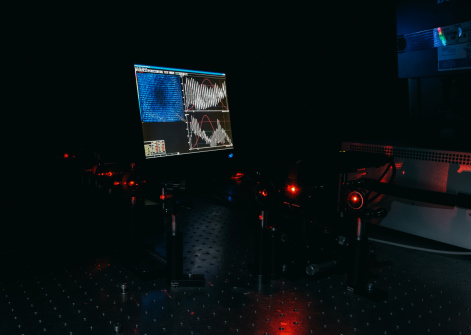Krasnoyarsk scientists investigated the diffraction of vortex laser beams
16 December 2020 г.

An optical vortex is light, with the wavefront being of a helical surface, whose axis coincides with the direction of light propagation. Falling on a flat surface, the optical vortex appears as a ring of light with a dark spot in the center. To characterize the vortex, the topological charge value is used, which depends on the number of complete revolutions of the wavefront around its axis at one wavelength. The higher the charge, the faster the light "twists", and the direction of twisting is determined by the positive or negative sign of the charge. Since their discovery, optical vortices have found wide application in telecommunications and optical manipulation.
Researchers from the Krasnoyarsk Science Center SB RAS and Siberian Federal University theoretically and experimentally studied the diffraction of optical vortices on a two-dimensional lattice and for the first time observed the associated Talbot effect for visible light with different topological charges.
The Talbot effect is a well-known optical phenomenon, which consists in the fact that when light passes through the periodic grating, there occurs successive diffraction and interference of light waves. As a result, at certain distances behind the grating, light intensity distributions are formed, which resemble the image of the grating.
To detect this effect in visible light, the scientists used a transparent silica plate covered with an opaque silver film. At the same time, a regular array of round holes was perforated in the coating. The light-opaque coating with an array of holes represented a diffraction grating required to observe the Talbot effect.
In addition to the effect itself, the authors of the study also obtained for the first time the so-called Talbot carpets for visible light with various topological charges. These are fractal patterns created from projected images. Such patterns indicate that the intensity of the diffracted light, forming optical gratings, is distributed in them in an orderly manner. Light in such lattices is symmetrical and forms a periodic spatial structure.
Studying the distribution of light intensity in more detail, the scientists were able to experimentally reproduce the unit cell of a three-dimensional optical lattice. To do this, physicists directed vortex laser beams onto a diffraction grating. Passing through it, the laser beams interfered with each other, to form ring-shaped structures.
Andrey Vyunyshev, Candidate of Physical and Mathematical Sciences, “The study of vortex laser beams is important for modern physics. It was important for us to experimentally detect the Talbot effect for vortex beams in the visible spectral range. The results of our calculations are in good agreement with experiments and can be used to create and optimize three-dimensional gratings from laser beams. The Talbot effect, for example, can be used in photolithography to obtain periodic submicron structures, whose dimensions are several times smaller than the size of the structural elements of the original mask. Under the action of a pulse and orbital angular momenta of light, micro-objects can be manipulated in biology, medicine, and materials science using ordered arrays of optical vortices. Our results will help to better understand the fundamental properties of matter and interaction of light with matter ”, - describes the results of the study Andrey Vyunyshev, Candidate of Physical and Mathematical Sciences, Deputy Director for Science at the L.V. Kirensky Institute of Physics SB RAS.
This research was supported by the Russian Science Foundation (project No. 19-12-00203).
Share:

